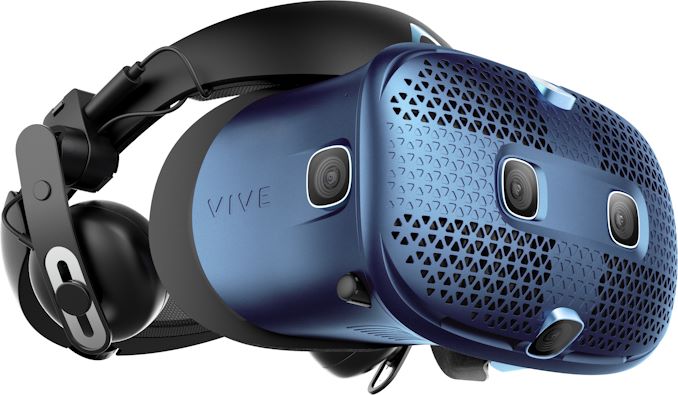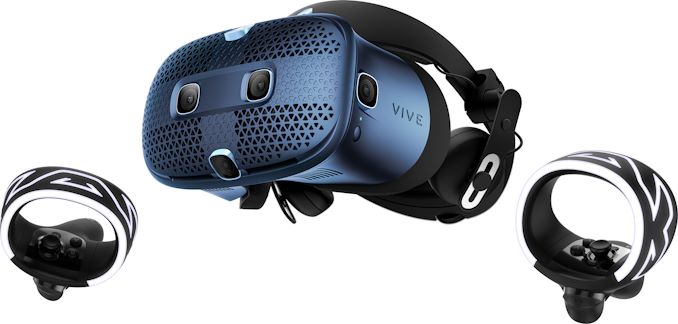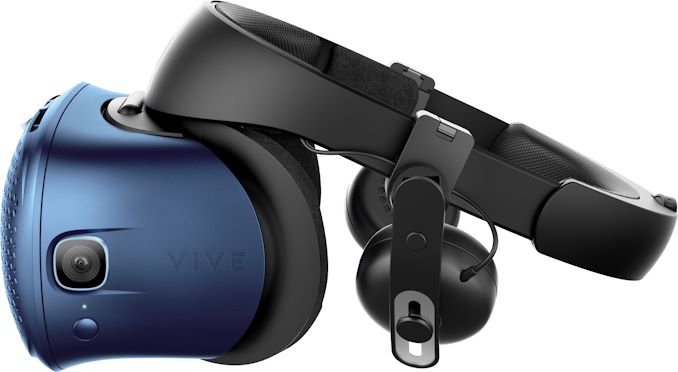HTC Unveils Final Specs & Availability Date of Cosmos VR Headset for PCs
by Anton Shilov on September 13, 2019 11:00 AM EST- Posted in
- VR
- HTC
- Vive
- Vive Cosmos

HTC this week announced final specifications as well as availability date of the Vive Cosmos, its next-generation tethered VR headset, which promises numerous improvements along with modularity for further upgrades. Among the key features of the Vive Cosmos are higher resolution displays, full 6DoF inside-out tracking built around six cameras and integrated sensors, a lower weight, as well as all-new knuckles-style controllers. The headset is available for pre-order now and will ship in early October.
Originally unveiled at CES early this year, the Vive Cosmos head mounted display (HMD) is equipped with two 3.4-inch RGB LCD screens, each offering a per eye resolution of 1440×1700 (2880×1700 combined resolution), a 90 Hz refresh rate, and a 110-degree field of view (officially, this is the same as the original Vive). On which note, HTC has been relatively mum on the optics used, though it has been confirmed that they're continuing to use Fresnel lenses.
As this is a tethered headset by default, in its standard configuration the HMD connects to a host PC using via DisplayPort 1.2 and USB 3.0. Alternatively, the VR HMD can be equipped with a WiGig-based wireless adapter from HTC.
The VR headset comes with a built-in inside-out 6-degree-of-freedom (6DoF) positional tracking enabled by six cameras, a G-sensor, as well as a gyroscope, which is an important distinction from the original Vive (and Vive Pro), as it does not require any external sensors for tracking. This greatly simplifies the setup process and removes some of the friction from using the device, though as a realistic assessment it's unlikely to be quite as stable as using external sensors. Like all HTC Vive HMDs, the Cosmos has its own spatial audio-supporting stereo headphones as well as microphones.
The new headset also comes with brand-new knuckle-style controllers, which are tracked by the HMD as part of its inside-out tracking. The controllers feature touch sensitivity, two application buttons, a trigger, a joystick, a bumper, and a grip button; all the common controls found on current-generation VR controllers. There is one notable caveat about the Cosmos controllers though: they are powered by two AA batteries and cannot be recharged from outside, which means that users will need to swap batteries after they get run down.
A unique capability of the Vive Cosmos is modular design of its front panel, which can be detached and replaced by another one, allowing upgrades and new features to be added. Fittingly, the very first ‘mod’ is the Vive Cosmos External Tracking Mod, and it is designed to allow the headset to be tracked externally using the SteamVR ecosystem's existing Lighthouse base stations (though this also means the Cosmos controllers cannot be used). This one will be available in Q1 2020 for under $200.
The new HTC Vive Cosmos has a lower weight compared to its predecessors, the manufacturer says without elaborating. Meanwhile, the HMD continues to use a headstrap similar to that of the Vive Pro, with a sizing dial and enhanced ergonomics that balance the weight for added comfort.
HTC’s Vive Cosmos VR headset will be launching on October 3rd for $699. However for anyone looking to get started right away, HTC has already started taking pre-orders this week.
Related Reading:
- HTC at CES 2018: Vive Pro VR Headset with Higher-Res Displays, Two Cams, Headphones
- Valve Index VR Headset: 1440×1600 per Eye and 120/144 Hz LCDs
- HP Reverb Virtual Reality Headset: A 4K HMD with 6DOF
- Oculus Rift S VR Headset: An Upgraded Virtual Reality Experience
Source: HTC













32 Comments
View All Comments
p1esk - Friday, September 13, 2019 - link
Why is resolution and refresh rate so low for a top of the line tethered headset in 2019?Death666Angel - Friday, September 13, 2019 - link
It has a higher resolution than the competing Valve and Oculus HMDs. And only the Index has a higher refresh rate. Only things with even higher resolution are Pimax and the HP Reverb.p1esk - Friday, September 13, 2019 - link
Are there any technical reasons why this thing can't be OLED 4kx4K@120Hz per eye? I'm not asking about video card limitations. Why is the headset itself so limited?SeannyB - Saturday, September 14, 2019 - link
My mostly wild guess is panel supply and price point, judging from the fact that the original HMDs went to LCD for their successor models, including the $1K Valve Index. The original Vive/Rift used a custom made-for-VR OLED panel. Maybe the asking price for an incremental improvement was too much, and the market for VR proved to be a low-volume niche rather than the next hottest thing.p1esk - Saturday, September 14, 2019 - link
Seems like VR market is in a tough spot: no one is buying because the technology sucks, but they can't improve the technology because no one is buying. I thought Facebook getting behind Oculus would break this vicious cycle. VR industry needs an 'iPhone moment'. And it's increasingly likely it will be Apple again to do it.brunis.dk - Sunday, September 15, 2019 - link
It isn't the software in VR that sucks, so it wont really benefit from a pricier headset with the same software.Oxford Guy - Sunday, September 15, 2019 - link
OLED isn't better than LCD in every respect, as far as I know. Blue OLED subpixels can have fading issues, which is why white subpixels were added to televisions (to mask the problem more). Motion blur may be higher. Image retention may be a factor.OLED does have the advantage of much better contrast than LCD.
plonk420 - Sunday, September 15, 2019 - link
nah, OLED has the best motion/persistence (IIRC the term) of any current tech. used to be the big thing Carmack would talk about first (i highly suggest his talks at dev conferences). now it's dealing with reducing latency to make it not suckSantoval - Monday, September 16, 2019 - link
If microLED based panels really have all the strengths of OLED panels and almost none of their weaknesses (including much higher endurance and roughly equal lifetimes for the red, green and blue subpixels) then perhaps that's the technology that will prevail in the mid to long term. The question is if microLEDs can scale easily at 4K-class resolutions and reasonable panel sizes of 30 to 50 inches. I don't know if that has been mastered yet, I keep hearing about them being used for huge panels (where the individual microLEDs do not have to be very small).Reflex - Monday, September 16, 2019 - link
TV’s don’t work that way, at least not LG panels. They use white OLED’s entirely and filter them through a colored film to produce colors. This results in an even brightness on all colors and avoids the color degradation issue as each color degrades at a different rate.As to the other parts, having had both LCD and an OLED tv, motion blur is considerably worse on LCD, and OLED is quick enough that even mismatched framerates produce far less stutter than they do on LCD’s.
Image retention certainly can be an issue, although in nearly two years I haven’t seen it. That said, I don’t live in front of my tv and I wouldn’t recommend a OLED for, say, a bar tv constantly tuned to a sports channel with a logo in a corner.